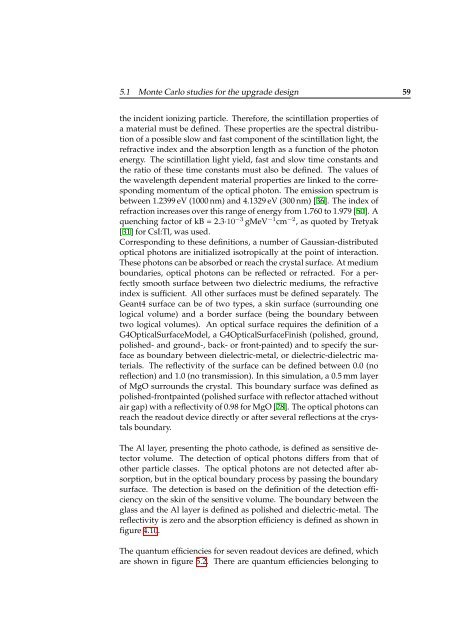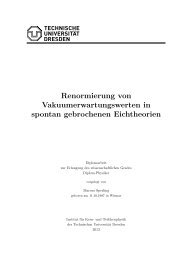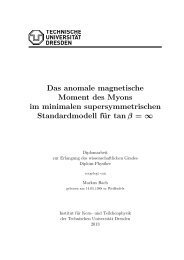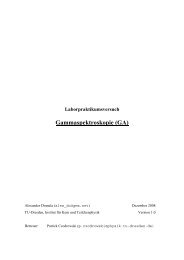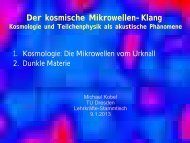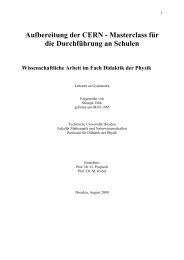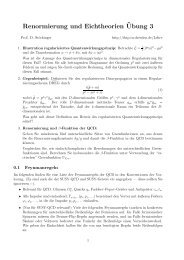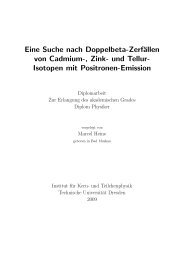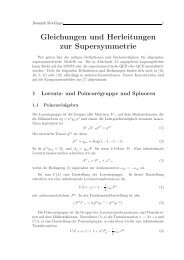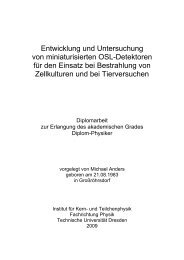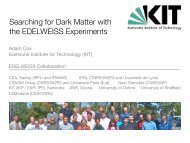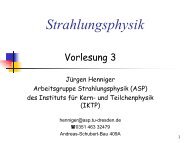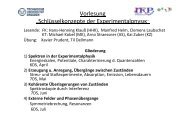a design study for a cobra upgrade to - Institut für Kern- und ...
a design study for a cobra upgrade to - Institut für Kern- und ...
a design study for a cobra upgrade to - Institut für Kern- und ...
You also want an ePaper? Increase the reach of your titles
YUMPU automatically turns print PDFs into web optimized ePapers that Google loves.
5.1 Monte Carlo studies <strong>for</strong> the <strong>upgrade</strong> <strong>design</strong> 59<br />
the incident ionizing particle. There<strong>for</strong>e, the scintillation properties of<br />
a material must be defined. These properties are the spectral distribution<br />
of a possible slow and fast component of the scintillation light, the<br />
refractive index and the absorption length as a function of the pho<strong>to</strong>n<br />
energy. The scintillation light yield, fast and slow time constants and<br />
the ratio of these time constants must also be defined. The values of<br />
the wavelength dependent material properties are linked <strong>to</strong> the corresponding<br />
momentum of the optical pho<strong>to</strong>n. The emission spectrum is<br />
between 1.2399 eV (1000 nm) and 4.1329 eV (300 nm) [36]. The index of<br />
refraction increases over this range of energy from 1.760 <strong>to</strong> 1.979 [50]. A<br />
quenching fac<strong>to</strong>r of kB = 2.3·10 −3 gMeV −1 cm −2 , as quoted by Tretyak<br />
[31] <strong>for</strong> CsI:Tl, was used.<br />
Corresponding <strong>to</strong> these definitions, a number of Gaussian-distributed<br />
optical pho<strong>to</strong>ns are initialized isotropically at the point of interaction.<br />
These pho<strong>to</strong>ns can be absorbed or reach the crystal surface. At medium<br />
bo<strong>und</strong>aries, optical pho<strong>to</strong>ns can be reflected or refracted. For a perfectly<br />
smooth surface between two dielectric mediums, the refractive<br />
index is sufficient. All other surfaces must be defined separately. The<br />
Geant4 surface can be of two types, a skin surface (surro<strong>und</strong>ing one<br />
logical volume) and a border surface (being the bo<strong>und</strong>ary between<br />
two logical volumes). An optical surface requires the definition of a<br />
G4OpticalSurfaceModel, a G4OpticalSurfaceFinish (polished, gro<strong>und</strong>,<br />
polished- and gro<strong>und</strong>-, back- or front-painted) and <strong>to</strong> specify the surface<br />
as bo<strong>und</strong>ary between dielectric-metal, or dielectric-dielectric materials.<br />
The reflectivity of the surface can be defined between 0.0 (no<br />
reflection) and 1.0 (no transmission). In this simulation, a 0.5 mm layer<br />
of MgO surro<strong>und</strong>s the crystal. This bo<strong>und</strong>ary surface was defined as<br />
polished-frontpainted (polished surface with reflec<strong>to</strong>r attached without<br />
air gap) with a reflectivity of 0.98 <strong>for</strong> MgO [28]. The optical pho<strong>to</strong>ns can<br />
reach the readout device directly or after several reflections at the crystals<br />
bo<strong>und</strong>ary.<br />
The Al layer, presenting the pho<strong>to</strong> cathode, is defined as sensitive detec<strong>to</strong>r<br />
volume. The detection of optical pho<strong>to</strong>ns differs from that of<br />
other particle classes. The optical pho<strong>to</strong>ns are not detected after absorption,<br />
but in the optical bo<strong>und</strong>ary process by passing the bo<strong>und</strong>ary<br />
surface. The detection is based on the definition of the detection efficiency<br />
on the skin of the sensitive volume. The bo<strong>und</strong>ary between the<br />
glass and the Al layer is defined as polished and dielectric-metal. The<br />
reflectivity is zero and the absorption efficiency is defined as shown in<br />
figure 4.10.<br />
The quantum efficiencies <strong>for</strong> seven readout devices are defined, which<br />
are shown in figure 5.2. There are quantum efficiencies belonging <strong>to</strong>


